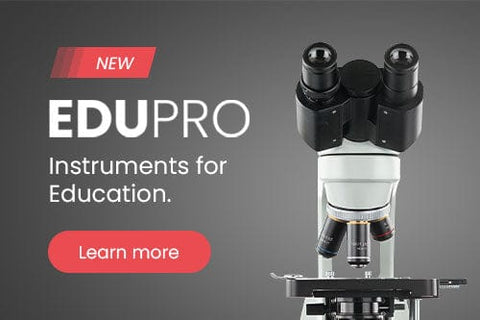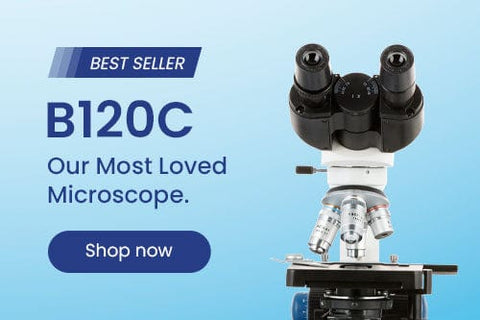- Microscopes
- Cameras
- Lab Supplies & Equipment
- Shop By Brand
- Lab Supplies by Category
- Analyzer Consumables
- Balances
- Bags
- Beakers
- Bench Scale Bases
- Bottles
- Bottletop Burettes
- Bottletop Dispensers
- Boxes
- Blank Microscope Slides & Cover Slips
- Blood Collection
- Caps
- Carboys
- Centrifuges
- Centrifuge Tubes
- Cold Storage
- Containers
- Cryogenic Vials
- Culture Tubes
- Cylinders
- Dispensers
- Digital Dry-Baths
- ESR Products
- False Bottom Tubes
- Flat Bottom
- Funnels
- Gel Documentation
- Glassware
- Glass Test Tubes
- Histology
- Homogenizers
- Hotplates-Stirrers
- Inoculation Loops and Spreaders
- Liquid Handling Products
- Manual-Electronic Pipettors-Pipettes
- Microscope Slides
- Overhead Stirrers
- Pipette Controller (Serological Filller)
- Pipette Tips
- Plastic Test Tubes
- PCR Tubes, Strips & Plates
- Racks
- Repeater Pipettor
- Rockers
- Rotary Evaporators
- Serological Pipettes
- Shakers
- Spectrophotometers
- Syringe Tips
- Sample Tubes
- School/Classroom Supplies
- Screwcap Test Tubes
- Self-Standing
- Test Tube Racks
- Test Tubes & Vials
- Transport & Storage Tubes
- Thermal Mixers
- Transfer Pipets
- Urinalysis
- Vacuum Pumps
- Weighing Dishes
- Lab Equipment
- Balances
- Bench Scale Bases
- Centrifuges
- Digital Dry-Baths
- Gel Documentation
- Homogenizers
- Hotplates-Stirrers
- Overhead Stirrers
- Pipettors
- Rockers
- Rotary Evaporators
- Shakers
- Serological Pipettes
- Spectrophotometers
- Thermal Mixers
- Vacuum Pumps
- Liquid Handling Products
- Manual-Electronic Pipettors-Pipettes
- Pipette Tips
- Racks
- Pipette Fillers-Controllers
- Repeater Pipettor
- Syringe Tips

Cost effective products and solutions designed to improve laboratory efficiency, safety and results.
SHOP BENCHMARK SCIENTIFIC >
- Slides & Accessories
- Slides
- Cameras
- Illuminators
- Adapters
- Eyepieces / Objectives
- Bulbs
- Magnifying Lamps
- Monitors and Tablets
- View All Categories
- Adapters
- DSLR Adapters
- USB Camera Adapters
- Ring Light Adapters
- Power Adapters
- Barlow Lens
- Books & Experiments Cards
- Bags & Cases
- Bags
- Cases
- Cameras
- Circuit Board Holders
- Cleaning Kits
- Condensers
- Darkfield
- Phase Contrast Kits
- Polarizing Kits
- Dust Covers
- Eye-Guards
- Eyepieces
- 20mm
- 23mm
- 30mm
- 30.5mm
- Filters
- Microscope Filters
- Illuminator Filters
- Fluorescence Kits
- Conversion Kits
- Filter Cubes
- Focusing Racks
- Fuses
- Illuminators
- Bulbs
- LED Illuminators
- Fiber Optic Illuminators
- Fluorescent Illuminators
- Ring Lights
- Stand Lights
- Goosenecks
- Gooseneck Attachments
- Immersion Oils
- Loupes
- Magnifying Lamps
- Clamp Lamps
- Desktop Lamps
- Rolling Stand Lamps
- Mechanical Stages
- Monitors and Tablets
- Calibration Slides & Stage Micrometers
- Stage Warmers
- Stain Kits
- Stands
- Articulating Arm Stands
- Boom Stands
- Table Stands
- Tweezers
- Other Accessories
- Shop By Industry
- Shop By Industry
- Botany
- Agronomy & Forestry
- Horticulture
- Phytopathology
- Chemistry
- Biochemistry
- Biotechnology
- Cannabis
- Pharmaceutics
- Consumables
- Beer & Wine
- Cosmetics
- Food & Beverage
- Electronics
- Circuit Boards & General Electronics
- Mobile Phone Repair
- Semiconductors & Wafers
- Environmental
- Asbestos
- Ecosystem Research
- Mud Logging
- Soil Treatment
- Water Treatment
- Forensics
- Ballistics
- Fingerprint Analysis
- Genetic Identification
- Hair & Fiber Analysis
- Handwriting Analysis
- Industrial
- Aerospace
- Automotive
- Dental Lab & Production
- Glass Industry
- Industrial Inspection
- Mechanical Parts
- Paper Industry
- Petrochemical
- Plastics
- Printing Industry
- Quality Assurance & Failure Analysis
- Textiles & Fibers
- Tool Making
- Wood Production
- Jewelry & Gemology
- Engraving
- Gemology
- Jewelry Repair
- Stone Setting
- Watch Repair
- Hobby
- Coins & Collecting
- Stamps
- Modeling & Assembly
- Sculpting
- Repair
- Telescopes
- Metallurgy
- Archaeology
- Geology
- Mining
- Petrology
- Medical & Microbiology
- Anatomopathology
- Bacteriology
- Biochemistry
- Cell Culture
- Cytology
- Dental Microbiology
- Dermatology
- Dissection
- Gout & Rheumatology
- Hair & Fiber Analysis
- Hair Transplant
- Fluorescence
- Hematology & Live Blood Analysis
- Histopathology
- Mycology
- Medical Devices
- Microsurgery
- Neuropathology
- Oncology
- Parasitology
- Pathology
- Semen Analysis
- Virology
- Veterinary & Zoology
- Breeding & Semen Analysis
- Entomology
- Fecal Smears & Floats
- Marine Biology
- Ornithology
- Veterinary Medicine
- Zoology
- Shop By Industry
- Students
- Telescopes
- Buy With Prime
- Sale
- Compound Microscopes
- Shop By Brand
- AmScope
- Euromex
- Omax
- Shop by Head Type
- Binocular
- Monocular
- Trinocular
- Multi-head & Training
- Shop By Specialty
- Brightfield
- Darkfield
- Phase Contrast
- Inverted
- EPIfluorescence
- Polarizing
- Digital Integrated
- Metallurgical
- Shop By Application
- Education
- Research
- Veterinary
- Compound With Digital Head
- Shop Best Sellers
- Shop All Compound
- Stereo Microscopes
- Shop By Brand
- AmScope
- Euromex
- Shop By Objective Type
- Fixed Power
- Zoom Power
- Single Lens
- Common Main Objective
- Shop By Stand Type
- Articulating Arms
- Boom Stands
- Gooseneck Stands
- Table Stands
- Other Stands
- Shop By Head Type
- Binocular
- Monocular
- Trinocular
- Simul-Focal
- Shop By Industry
- Video Inspection
- Industrial Inspection
- Microscope Heads
- Shop Stands
- Articulating Arm
- Boom Stands
- Table Stands
- Stereo With Digital Head
- Shop Best Sellers
- Shop All Stereo
- Specialized Microscopes
- Digital Microscopes
- Kids, Student Microscopes
| Amscope Team
Coarse vs Fine Adjustment Knob: What’s the Difference?
Coarse vs Fine Adjustment Knob: Discovering the Differences and Functions
Compound light microscopes are a critical part of the lab. Whether you’re introducing students to the magic of the microscopic world or performing medical research, you count on your microscope to provide high-quality images of your specimens. Part of the imaging technology of a microscope relies on the prudent use of coarse vs fine adjustment knobs.
Resolution in Microscopes: The Stage Adjustment Knobs
A microscope can enlarge images due to the balance between magnification and resolution. The rotating magnifying lenses provide options to view your specimen at different multipliers. For compound light microscopes, the magnification is calculated from the product of the eyepiece and the objective lens multipliers. However, if your specimen is magnified by 400x but looks like a blurry grey blob, what’s the point? That’s where resolution comes in.
Resolution is the level of detail in an image. It’s the same in photography or videography – a higher resolution shows more definition and a clearer picture. In microscopy, you adjust the resolution by manipulating the distance between the stage and the lens. The two-stage adjustment knobs provide the operating mechanism for refining the image resolution.
How the Fine and Coarse Knobs Differ
There are differences between the coarse adjustment knob vs the fine adjustment knob. The adjustment knobs on a microscope are both used for focusing on the microscope slide. However, they differ in the range of movement. For starters, the coarse knob changes the level of the slide stage very noticeably. Turning the knob will change the level by centimeters. By contrast, the fine knob is much more subtle. It moves the stage a millimeter at a time.
Another difference between the two knobs is the breadth of movement. The coarse knob has a full range of motion and can move the stage from its lowest to its highest point. In contrast, the fine knob has a much smaller range; a complete revolution will only move the stage a fraction of its full range of motion.
How They Function Together
Using both the coarse and fine adjustment knobs together allows for efficiency and accuracy. When used in tandem, you can get your image into detailed focus.
How and When To Use:
The basics of microscopy teach the best practice of starting from the furthest scale and progressively narrowing in. When you initially load a slide, the stage should be at its lowest point to prevent any damage to the lens or slide. To start bringing your specimen into focus, always use the coarse control knob first. Then make your final tweaks with the fine adjustment knob. Here, find more detail on how the coarse and fine focus knobs work.
Location of the Coarse and Fine Focus Knobs
Depending on the exact type of microscope you are using, the location of the adjustment knobs may differ. In some cases, the coarse focus knob sits more centrally on the arm of the microscope with the fine focus knob positioned below it. Other microscopes may have both knobs on the same axle (coaxial microscopes), with the fine focus knob outer and the coarse knob closer to the body of the scope. In either style, the size of the knobs will indicate their function. The fine focus knob is smaller in diameter than the coarse focus knob.
The Coarse Focus Knob
The coarse focus knob should always be used first. Before adding your slide to the mount, lower the knob so the stage is at its lowest point. While using the lowest power objective lens, slowly turn the coarse adjustment knob to bring the specimen into focus. The coarse focus knob should only be used for the lowest-power lenses.
The Fine Focus Knob
For higher-powered objective lenses, use the fine focus knob to increase the resolution of your specimen. Even with the lowest-powered lens, the fine focus knob can bring the image to higher clarity. To use the fine focus knob, the first step is to choose your objective lens. Then, slowly rotate the fine adjustment knob until the specimen comes into focus.
The Tension Adjuster
Sometimes the stage adjustment knobs loosen and the stage slowly falls from the intended level. Low tension causes the stage to drift and unfocuses the microscope. To fix this, use the tension adjuster knob to control how tightly the stage adjustment knobs are held.
Where Is the Tension Adjuster?
Often, the tension adjuster is attached to the coarse adjustment knob. Depending on the exact type of your microscope, it might be a separate knob or a thin ring just inside the coarse adjustment knob.
How To Use a Microscope’s Tension Adjuster
For most simple student microscopes, the tension adjuster is a small knob on the inner side of the coarse adjustment knob. To increase the tension, simply tighten the knob. The ideal tension should securely hold the stage at a consistent level, but not make it too difficult to turn the stage adjustment knobs.
Some microscopes have a very thin ring that adjusts the tension. Some may even be labeled “tension” with an arrow to indicate the direction of tightness. These can be difficult to adjust with your hands and come with specific tools to assist. The tools may have a small hook to grab onto a hole in the ring or wrap around the ring like a wrench.
Some stereomicroscopes don’t have separate tension adjustment knobs. In that case, the tension is adjusted by turning both coarse adjustment knobs in opposite directions, simultaneously.
High-Quality Compound Microscopes at Unbeatable Prices
Both the coarse and fine microscope adjustment knobs control the resolution of your specimen. Each control knob plays a critical role in bringing your image into focus. For the best resolution, you want a microscope with high-quality lenses so when you focus on your slide, you can see every detail. Whether you’re analyzing the center spindle in a mitosis lesson with students or studying specific bacteria in the lab, choose the best compound microscope for the job. Peruse our selection at AmScope to find the best fit for the classroom or laboratory.
Free Shipping on orders $149+
Same day shipping for orders within the contiguous U.S.
Easy Returns
Hassle-free 30-day return policy. 100% satisfaction guarantee.
Quality Products
5-year warranty on AmScope microscopes.
Got a question?
Speak to our team of experts and find the products you need.
















